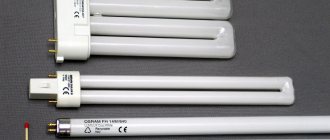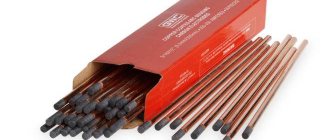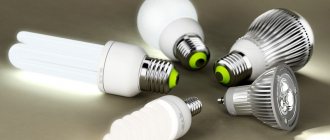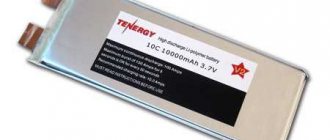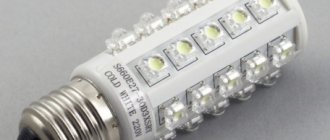The existence of modern civilization is impossible to imagine without electricity. It is used in all spheres of human activity. Of course, there were times when electricity had not yet been invented, but how limited were the capabilities of man of that era. Today, the cessation of energy supply, even for a minimal period of time, leads to complete paralysis of human life. What about remote regions where power lines have not yet reached? This justifies numerous and long-standing attempts by scientists to harness the sun's free energy to generate electricity. From the accidental discovery of the phenomenon of the photovoltaic effect by the French physicist A. Becquerel in 1839 and the invention of the first photovoltaic cell in 1873, to the start of commercial production of solar cells in the second half of the twentieth century, there were dozens of discoveries. But today, devices that convert sunlight into electricity are increasingly entering our everyday lives and serve as an excellent alternative to centralized energy supply.
There are entire cities that completely meet their electricity needs by converting solar energy. In Russia, solar-powered lighting devices are often used in country and private homes. This type of lamps is also used on highways, city streets and other places difficult to reach for electricity.
How does a solar lamp work?
The basis of the lamp, which ensures its functionality, is a solar battery. To date, this is its most expensive component. A solar panel is a collection of photovoltaic cells that, when exposed to sunlight, produce electrical current using the photovoltaic effect.
The design is made of two layers of silicon semiconductors with different conductivities. When the upper “solar” layer, which acts as a cathode, is heated by sunlight, electrons from the silicon atoms are “knocked out” by photons of light. After which they flow to the atoms of the lower plate, which serves as the anode. From the bottom plate, electrons move along connecting wires through the battery, charging it, and return to the top plate.
Depending on the structure of silicon crystals, there are three types of photocells for solar panels:
- polycrystalline;
- monocrystalline;
- amorphous.
The production of polycrystalline panels is the least expensive, but such solar cells have a low efficiency when converting light energy into electricity. Monocrystalline solar cells have a maximum efficiency of 25%. In this case, the silicon crystals have fewer edges, which allows electrons to travel at higher speeds. The cost of such batteries is correspondingly higher, but to generate the same amount of electricity, a smaller area of photocells is used than in the case of polycrystalline models. The production of amorphous panels requires several times less silicon than the production of crystalline analogues. At the same time, they are able to generate electricity in low light conditions, therefore they are considered more efficient in regions with a small number of sunny days.
The next important element in a solar battery is the battery. It is designed to store the energy that the panel produces. Typically, nickel-metal hydride or nickel-cadmium models are used, which can withstand a large number of charge-discharge cycles.
To avoid overcharging the battery, the lamp includes a charge controller. Depending on the charge level, it connects or disconnects the solar panel. The controller can perform the function of automatically turning on the lights at dusk. On some models this option is duplicated by a mechanical switch. More complex types of devices are capable of controlling the maximum power level.
The list of elements of a solar panel may include an inverter - a DC-AC converter. The stabilizer is designed to protect the system from possible voltage surges.
Light sources in solar-powered lamps are most often made using LEDs. They consume a small amount of energy, do not heat up and have a long warranty period.
All of these components are housed in a housing that is resistant to direct sunlight, precipitation and dust. Sometimes the solar battery is structurally located separately from the lamp itself.
Main Features of Garden Solar Lanterns
Solar lamps can be grouped into three groups according to the following characteristics:
- Features of design and construction. They in turn are divided into:
- bollards . They are made in the form of columns and are an effective element in garden design;
- built into steps ;
- used for illuminating ponds . Such lamps are immersed in water;
- used in the decorative design of flower beds and flower beds. During the day, the lamps merge with the plants, and at nightfall they focus attention on the floral arrangements;
- used to illuminate isolated trees . A tree trunk, engulfed in the twilight by a directed beam of light, will look very impressive and unusual.
- Qualitative characteristics. The photocell used in solar lamps is made of silicon, or rather from its modifications. Traditionally, polycrystalline silicon is used. Its quality is significantly inferior to monocrystalline silicon, since this modification of the chemical element is covered with an oxide film upon first contact with the air. It protects the photocell from environmental influences.
- Glass surface:
- smooth glass reflects most of the direct light and about half of the diffuse rays;
- structured glass collects diffusely scattered radiation ;
- Tempered glass has the best qualities .
Advantages and disadvantages of solar-powered lamps
In order to know how to choose the right solar-powered lamp, you need to correctly evaluate their advantages and disadvantages.
This equipment has the following advantages over conventional lamps.
- Autonomy. There is no need to lay wires from the central power supply to the lamp. Solar-powered lamps do not require regular battery replacement.
- Compactness. Household models of such lighting devices are lightweight, small in size and have universal fastening, which allows them to be moved without special equipment.
- Economical. There is no need to pay for electricity. LED lamps used in modern lamps have a very long service life.
- Simplicity and ease of installation. When installing lamps, no special professional skills or special tools are required.
- Electrical and fire safety. The equipment is not connected to the mains. During operation, the possibility of contact with the electrical filling of the device is eliminated, and the lamps do not heat up.
It is important to consider not only the pros, but also the disadvantages of this type of lighting elements.
- Dependence of functioning on climatic factors. The greater the latitude, the shorter the daylight hours. The number of sunny days in most regions of our country is also small. Solar panels may not provide enough energy to fully charge the battery and operate the lights effectively at night. It is advisable to use such lamps in central Russia only in the summer.
- Unstable lighting level. During operation, the brightness of the lamps gradually decreases as the battery discharges. This is especially noticeable during long nights.
- The likelihood of failure of the lamp in extreme weather conditions. In extreme cold, problems may arise with the functioning of batteries, and in extreme heat, overheating and failure of semiconductors cannot be ruled out.
- Increased maintenance requirements. Solar panels can become clogged during operation, which will lead to a decrease in the performance of the lamps. If the battery or LED lamp fails, repair is not advisable. The product will have to be disposed of and replaced.
Design and principle of operation
The brightness of the device depends on the number of LED lamps, and the operating time depends on the battery capacity. To ensure that the performance of street lamps does not disappoint, all this must be taken into account when purchasing.
Autonomous flashlights have a simple device:
- Solar battery. Converts solar energy into electrical current.
- LED lamp. There is a cold or yellow (warm) glow. There are dynamic models with a gradual transition from one color to another.
- Battery. It accumulates tension during the day and releases it at night.
- Controller. Serves to convert voltage.
- Photocell. Necessary for automatically turning on or off the light.
- Housing and fastening parts.
Additionally, the lamps can be equipped with motion sensors and light level adjustment. Some models have sound effects.
The devices work on this principle: the battery converts energy coming from the sun into electric current, which, in turn, charges the battery. After darkness sets in, the photocell in the lantern is activated , and the device begins to operate in diffused glow mode.
Garden lights do not have a very large battery capacity; if fully charged, they will work for no more than 8-9 hours. In summer, this is enough to illuminate the area at night. During the autumn period, daylight hours are shortened, and lanterns may run out of charge before dawn.
It is not advisable to install solar lights in shady areas of the garden; here they simply will not be able to charge.
How to choose the right solar lamp
When installing lighting, first of all, you need to analyze the technical characteristics of the model you like in order to understand what area and how brightly the device can illuminate. This directly affects the required number of lamps and the distance between them. Not everyone can immediately understand the rated power of LED lamps, which is why the lamp data sheet usually indicates the corresponding number for a similar incandescent lamp.
Buyers who have studied physics well at school can try using reference books to convert power watts into lux, lumens per meter or phot. To mark paths or garden objects, as well as for decoration, low-power devices are used, providing illumination of up to 100 lm. To fully illuminate an area of the territory, luminaires with more powerful lamps are selected, guaranteeing a value of 700 Lm and higher.
For long-term and reliable operation, solar-powered lamps must have a housing and shade protected from dust and moisture. The degree of protection from the influence of external factors is indicated by the IP index indicated in the device passport. For street lamps, the index value must be at least IP44.
You should also pay attention to the material from which the device is made. Most often it is impact-resistant plastic, aluminum, bronze or stainless steel. Such lamps do not become rusty and retain their appearance for a long time. When choosing a device based on the body material, it is customary to focus on the concept of landscape design and the operating conditions of the lamp. The lamp may also have a wooden body, but then it will have to be periodically treated with protective agents.
When purchasing a solar-powered lamp, you need to pay attention to the parameters of the battery that comes with the device. The larger the capacity, the longer the lamp will work at night and the longer it will take to charge during daylight hours.
As additional options, luminaires can include sensors that monitor the level of illumination and volume sensors that respond to movement. These elements ensure rational consumption of battery power, automatically turning on the lighting when it gets dark and turning it off in the morning. The device will also turn on in response to the approach of a moving object and turn off after a while.
Taking into account the different installation principles, lamps can be classified into the following groups.
- Ground. Such lamps have a small height and are mounted on a stand with a pointed end, which is simply stuck into the ground. They are ideal for marking paths or highlighting flower beds and can be moved to another location without much effort.
- Pole lamps. Models with a stand height above 1.5 meters. Due to their massiveness, they require some excavation work during installation. There are lamps for installation on paving slabs, asphalt or other hard surfaces. The stand in this case has a flange at the lower end.
- Lamps for vertical surfaces. Mounted on a wall or fence. The range of models is striking in their variety of styles - from the classic gas city lantern to high-tech models.
- Pendant lamps. This includes models that mount to ceilings, beams, and even trees. Used as decorative lighting for recreation areas and gazebos.
- Recessed lamps. Mounted inside vertical or horizontal surfaces. Ideal for illuminating stairs at tread level.
- Decorative lamps. They look like fairy-tale figurines for landscape decoration.
Degree of protection
An outdoor garden lamp will be regularly exposed to moisture: rain, watering, and possibly children’s games. To ensure that nothing is damaged, the housing must be adequately protected. When studying the characteristics of the product, pay attention to the letters IP in the marking. After them there should be two numbers - we need a lamp with IP44 and higher . For lamps that are installed under water or on water, the degree of protection against water should be maximum – IP67, or better yet IP68.
Installation Rules
A competent choice of installation location for a solar-powered lamp is the key to its long-term operation with the parameters declared by the manufacturer.
The main task is to ensure maximum illumination during daylight hours. Even a slight shadow falling on the surface of the semiconductor panel does not allow the battery to be fully charged and ultimately affects the performance of the battery. Choose an area that is as open as possible without tall trees, bushes, or buildings that cast shadows. In this case, you will be able to fully appreciate the beauty of the lamp.
Operating conditions for devices
When equipping a garden plot with lighting fixtures, every owner expects that they will last a long time and maintain a presentable appearance. To do this, you must strictly follow the operating requirements.
Lamps that are not intended for installation in an area with high humidity should not be placed near bodies of water. Only floating lanterns are highly sealed, allowing them to come into contact with water.
The operation of the lamps is entirely dependent on sunlight hitting the surface of the battery, so the devices must be regularly wiped of dust.
Upon completion of seasonal work before the onset of winter cold, the lanterns are removed indoors, the battery is removed and left at room temperature until spring.
Properly selected lighting fixtures decorate facades, paths and ponds and give the garden area a special charm and comfort.
How to turn on a solar lamp
In retail stores, luminaires must be sold with a fully charged battery. During long-term storage, even if the device was not turned on for a short time and was not placed on a display shelf, the battery will still lose some of its charge. To extend its service life and maintain its capacity parameters, it is advisable to first perform a discharge cycle and then charge it to the maximum value.
Solar energy is the energy of the future. By choosing lighting with photo panels, you choose independence and environmental friendliness. Install light in your dacha or cottage yard and evaluate the capabilities of such lamps.
Places of use
Depending on the location and tasks performed, street lighting devices are divided into the following categories:
- park lanterns - provide light to large areas, have a high leg with a stand at the bottom.
- street lamps - designed to illuminate streets, suspended or mounted on poles and supports, structural elements of buildings, etc.
- for illuminating gazebos, terraces, verandas and other semi-open buildings located on the street.
- garden lanterns for illuminating paths are not only sidewalk indicators, but also create sufficient visibility to navigate them in the dark.
- decorative - intended for decorating house and garden areas.
How to install the lantern?
In order to install such a lantern in the garden, you do not need to carry out excavation work, lay trenches, stretch an electrical cable, and especially call a specialist. The lanterns have special legs (for concrete) or a peg-shaped device that just needs to be stuck into the lawn.
The only condition is that you do not use brute force or a hammer. If the ground on your site is hard, first dig a hole with a shovel or scoop, carefully install a lamp in it and compact the soil on the sides.
Improving garden lamps
Inexpensive garden lights, usually made in China, have some flaws. The main problem with such devices is their short operating time. The flashlight burns for several hours, after which the battery is discharged and the light goes out until the next charging cycle. This problem can be easily corrected by installing a power limiting resistor on the board in front of the LED.
It is necessary to select its rating so that it passes a current of 4-5 mA, this is enough to power the LED normally, but will significantly reduce the rate of battery discharge. Then use a sharp utility knife to cut the path leading to the LED contacts and solder the resistor. For a red LED, its value is usually in the range of 75-91 Ohms , and for a green LED, a resistor of 45-62 Ohms .
Standard batteries usually fail after a year of use. Instead of a failed nickel-cadmium battery, you can use a nickel-manganese battery, the cheapest, since it will still not be fully charged. We wrote in detail about batteries for solar panels here.
Adding colors
To increase the decorative effect of garden lamps, you can replace LEDs with colored ones . You can use different combinations to get interesting light combinations and effects. The only condition will be proper installation of color LEDs, since not all circuits allow such intervention. The supply voltage may not meet the needs of the element; it will work for several hours and go out forever. In order to exclude such an outcome, you should install an additional resistor that reduces the voltage at the contacts of the color LED.
Advantages and disadvantages
The advantages of using lanterns equipped with solar panels include:
- Possibility to implement an autonomous lighting system for the territory.
- Environmental safety of such devices.
- Reducing the cost of paying bills for consumed electrical energy.
- Easy installation and maintenance of devices.
- Long service life.
- Possibility of use in the design of the territory.
The disadvantages are:
- Seasonality of use.
- Lighting requirements at the location.
- High price.
How to make it yourself
Having skills in handling electrical devices and the ability to work with a soldering iron, you can make a solar-powered lantern with your own hands.
For this you will need:
- Solar battery, preferably made of polycrystalline silicon.
- The battery is most suitable lithium-ion.
- LED or several LEDs.
- An electronic control unit responsible for monitoring the battery charge.
- The lamp housing, or any other housing in which the lamp will be assembled.
The electronic control unit can be assembled using individual electronic elements (transistors and diodes), as shown in the diagram below, or using microcircuits and other devices.
After the electronic unit is manufactured, the entire circuit is assembled. For convenience, you can purchase a universal DIY PCB board measuring 42x25mm, after which all elements are placed in the case and installed at the installation site.
